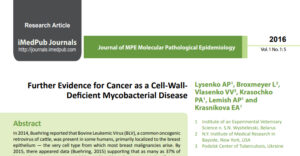Virus, bacteria, and fungal causes of cancer:
Viruses
- HPV (Human Papillomavirus)-Cervical Cancer
- EBV (Epstein-Barr)-Nasopharyngeal Cancer, Hodgkin’s Lymphoma and Gastric Cancer.
- HBV(Hepatitis B) and HCV (Hepatitis C)-Liver Cancer, Non-Hodgkin Lymphoma.
- HIV (Human Immunodeficiency Virus)- Kaposi Sarcoma, Cervical Cancer, Non-Hodgkin’s Lymphoma and a lot of other cancers due to the suppression of T cells.
- HHV-8 (Herpes)-Kaposi Sarcoma, Lyphoma
- HTLV-1 (Human T-Lymphotrophic Virus-1)-Lymphocytic Leukemia and Non-Hodgkin Lymphoma
- MVC (Merkel Cell Polymavirus)-Merkel Cell carcinoma.
- SV40 (Simian Virus 40) from the polio vaccine-Mesothelioma, brain, bone cancer and lymphoma.
Bacteria
- H.pylori (Helibacter pylori) -Stomach cancer.
- Chlamydia- Associated with Cervical cancer
Oral bacteria like Fusobacterium are associated with colorectal cancer, and also there are many cases of mycobacterium mimicking cancer.
Fungus
Pancreatic cancer has recently been associated with a fungus called Malassezia.
Here is new information; L-shaped bacteria!
L-shaped bacteria (bacteria without a cell wall) are fascinating!
Normally bacteria is classified cocci(spherical), bacillus (rod-shaped), or spiral. At least that’s what we learn in college.
New information (or at least newly accepted) shows that most bacteria when stressed have the ability to change shape and/or lose their cell wall. The method for identifying bacteria is to stain the cell wall, so without a cell wall it can’t be stained for identification and is very difficult to detect. This is probably why a link to cancer hasn’t been made sooner.
What stresses bacteria? Antibiotics are known to stress bacteria and induce change to the L-shape becoming resistant to antibiotics and invisible to the immune system.
Normal bacteria when stressed will change shape from cones to rods and can shed it’s cell wall entirely to very closely resemble a virus and then it can hijack the immune system by living in white cells and delaying apoptosis beyond the normal 45 day cell cycle. It’s then able to take control of hosts genetic material, which allows it to create proteins that enhance it’s survival.
L-shaped bacteria causes inflammation and has been found in continual presence in ALL types of cancer.
Fungus is also included in L-shaped bacteria and cell wall variant organisms.
Click here for a fascinating read bout L-shape bacteria!
Need more proof cancer is an organism?
Study- In this study they gave mice fecal transplants from CRC patients and the mice developed lesions with characteristics of malignant tumors!!! What bacteria was in there? I paid for the full study and several were implicated including Fusobacterium!
Fusobacterium is thought to be the cause of colorectal cancer.
I’ve often wondered if a person with CRC was targeting Fusobacterium with treatment and it didn’t work, what could the reason could be?
Maybe the difference in treatable CRC and advancing CRC is Fusobacterium has switched to L-shape becoming undetectable by normal lab testing and also resistant to most treatment.
Study-This study points to mycobacterium along with a secondary infection with a different bacteria as the cause of most cancers.

How often is the secondary bacteria found to be Fusobacterium I wonder?
There are many of strains of Fusobacterium, the most virulent one’s shared a commonality with mycobacterium- chorismate mutase domain.
The study shows the average time it takes mycobacterium to induce cancer is 20 years although there have been short term cases as well that document mycobacteria mimicking cancer.
All of this information led me to wonder what kills mycobacterium….
In bladder cancer they use a treatment called BCG, it’s diluted Mycobacteria Bovis to which combats other Mycobacteria strains. It’s the only agent approved by the FDA as the primary therapy of carcinoma of the bladder.
Falcarinol in carrots can kill mycobacterium! Great study here!
Other common anti-cancer plant compounds were shown to work such as garlic, berberine, curcumin, EGCG, quercetin, colloidal silver, vitamin C and many more.
I even found a chart with plant flavonoids including the percent they were effective in inhibiting mycobacterium. Top effective substances are listed below and what they’re commonly called.
88.69 Pectolinarine- Cirsium chanroenicum
84.03 Baicalein- Scutellaria baicalensis and Scutellaria lateriflora.
83.6 Isoliquiritigenin- Licorice
82.06 Hispidulin- Grindelia argentina, Arrabidaea chica, Saussurea involucrate, Crossostephium chinense, Artemisia and Salvia species. Hispidulin have antioxidant, antifungal, anti-inflammatory, antimutagenic, antineoplastic propertie
84.5 Myricetin-Berries
74.4 Quercetin- Onions, apples
74.34 Icarrin- Horny Goat Weed or Yin Yang Huo
73.09 Emodin- Japanese knotweed
69.59 Costunolide- Saussurea costus roots
69.56 Tripterine- Tripterygium wilfordii
69.53 Curcumin-
Mycobacterium or any other L-shaped (no cell wall) bacteria could be the common denominator in how people have cured themselves with different methods.
I’ve been thinking about all the cancer survivors I know and wondering if the method they used to recover could be something that killed a bacteria with no cell wall.
That led me to the discovery that Mycobacterium is fueled by fat, amino acids (protein) and glucose. A plant based diet is naturally low in fat, amino acids (protein) and glucose and could easily be high in plants that inhibit mycobacterium.
Could killing bacteria without a cell wall be the universal cure?
This theory seems possible. I know endless plant based cancer survivors, a case of complete remission of squamous cell carcinoma using colloidal silver (kills mycobacterium), complete remission of Multiple Myeloma with curcumin (kills mycobacterium) which scored high on the flavonoid chart, Jim Gordon’s stage 4 remission with herbs that just happen to kill Mycobacterium, remission from various cancers with anthelmintic drugs that also kill mycobacterium…..this could be an overlapping factor in their survival!